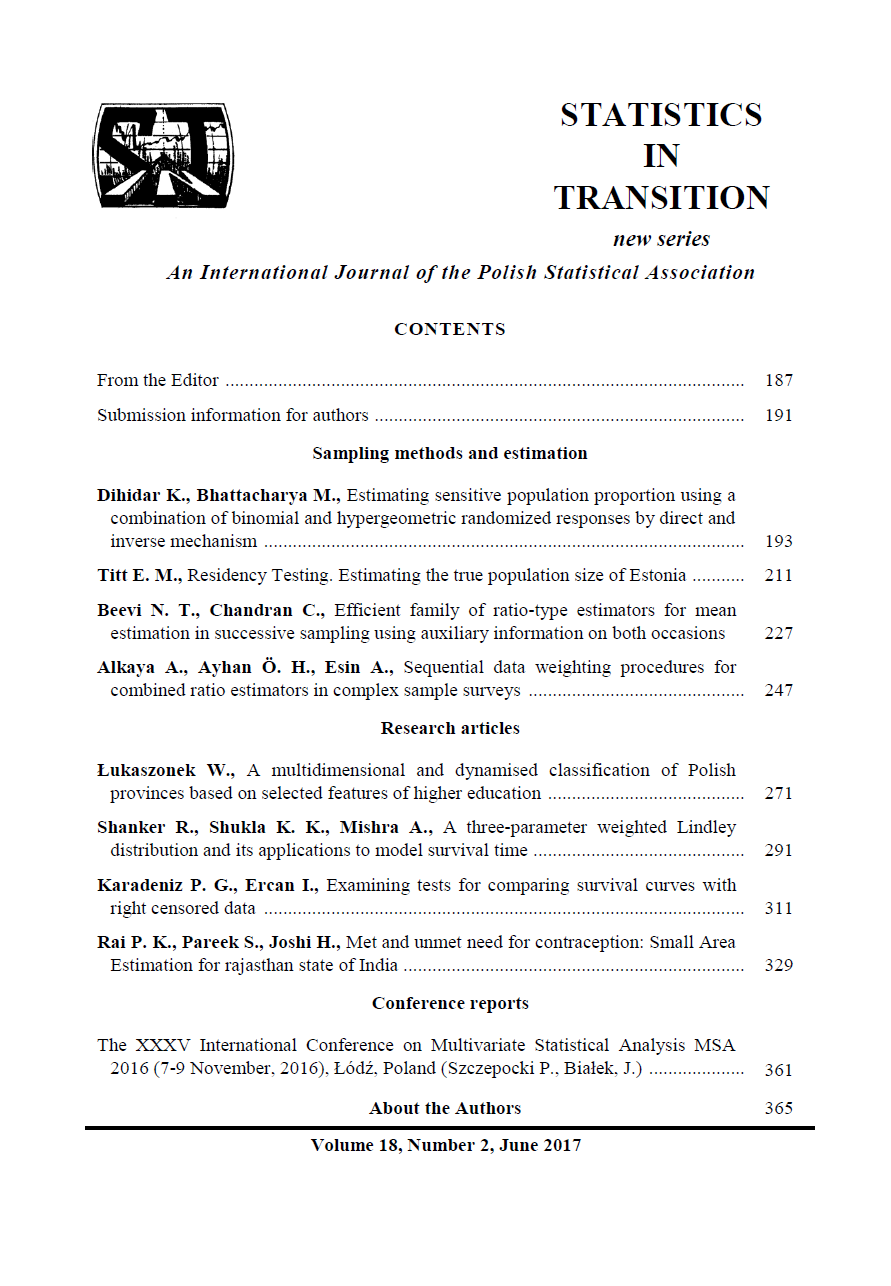ARTICLE
ABSTRACT
For various reasons individuals in a sample survey may prefer not to confide to the interviewer the correct answers to certain potentially sensitive questions such as the illegal use of drugs, illegal earning, or incidence of acts of domestic violence, etc. In such cases the individuals may elect not to reply at all or to reply with incorrect answers. The resulting evasive answer bias is ordinarily difficult to assess. The use of a randomized response method for estimating the proportion of individuals possessing those sensitive attributes can potentially eliminate the bias. Following Chaudhuri and Dihidar (2014) and Dihidar (2016), here, as a possible variant, we have made an attempt to estimate the sensitive population proportion using a combination of binomial and hypergeometric randomized responses by direct and inverse mechanism. Along with the traditional simple random sampling, with and without replacement, we consider here sampling of respondents by unequal probabilities. Essential theoretical derivations for unbiased estimator, variance and variance estimators are presented for several sampling schemes. A numerical illustration is performed to make a comparative study of the relative efficiencies of the direct and inverse mechanism..
REFERENCES
BORUCH, R. F., (1971). Assuring confidentiality of responses in social research:A note on strategies, The American Sociologist, 6, 308–311.
CHAUDHURI, A., (2011). Randomized response and indirect questioning tech niques in surveys, CRC Press, Boca Raton, FL.
CHAUDHURI, A., BOSE, M., DIHIDAR, K., (2011a). Estimation of a sensitive proportion by Warner’s randomized response data through inverse sampling.Statistical Papers. 52, 343–354.
CHAUDHURI, A., BOSE, M., DIHIDAR, K., (2011b). Estimating sensitive pro portions by Warner’s randomized response technique using multiple random ized responses from distinct persons sampled, Statistical Papers, 52, 111–124.
CHAUDHURI, A., CHRISTOFIDES, T. C., RAO, C. R., (2016). Handbook of Statistics 34, Data gathering, analysis and protection of privacy through ran domized response techniques. Elsevier, Amsterdam.
CHAUDHURI, A., DIHIDAR, K., (2014). Generating randomized response by inverse mechanism. Model Assisted Statistics and Applications, 9, 343–351.
CHAUDHURI, A., MUKERJEE, R., (1987). Randomized response techniques: a review. Statistica Neerlandica, 41, 27–44.
CHAUDHURI, A., MUKERJEE, R., (1988). Randomized responses: Theory and Techniques, Marcel Dekker, New York, NY.
CLARK, S. J., DESHARNAIS, R. A., (1998). Honest answers to embarrassing:Detecting cheating in the randomized response model. Psychological Meth ods, 3 (2), 160–168.
DIHIDAR, K., (2016). Estimating sensitive population proportion by generating randomized response following direct and inverse hypergeometric distribution.Handbook of Statistics, 34 : Data Gathering, Analysis and Protection of Pri vacy Through Randomized Response Techniques: Qualitative and Quantita tive Human Traits. Edited by Arijit Chaudhuri, Tasos C. Christofides and C.R. Rao. Elsevier, North Holland, Amsterdam, The Netherlands. 427–441.
EICHHORN, B. H., HAYRE, L. S., (1983). Scrambled randomized response methods for obtaining sensitive quantitative data. Journal of Statistical Plan ning and Inference, 7, 307–316.
FETH, S., FRENGER, M., PITSCH, W., SCHMELZEISEN, P., (2015). Cheater Detection in the Randomized Response technique: derivation, analysis and application. Monsenstein & Vannerdat.URL: http://universaar.uni-saarland.de/monographien/volltexte/2015/134/
GJESTVANG, C. R., SINGH, S., (2006). A new randomized response model.Journal of the Royal Statistical Society, Series B, 68, 523–530.
GREENBERG, B. G., ABUL-ELA, ABDEL-LATIF, A., SIMMONS, W. R.,HORVITZ, D. G., (1969). The unrelated question RR model : theoretical framework. Journal of the American Statistical Association. 64, 520–539.
HANSEN, M. H., HURWITZ, W. N., (1943). On the theory of sampling from finite populations. Annals of Mathematical Statistics, 14 (4), 333–362.
HAUNG, K. (2004). A survey technique for estimating the proportion and sensi tivity in a dichotomous finite population. Statistica Neerlandica, 58, 75-82.
HEDAYAT, A.S., SINHA, BIKAS. K., (1991). Design and Inference in Finite Population Sampling. Wiley.
HORVITZ, D. G., THOMPSON, D. J., (1952). A generalization of sampling with out replacement from a finite universe. Journal of the American Statistical Association, 47, 663–685.
HORVITZ, D. G., SHAH, B. V., SIMMONS, W. R., (1967). The unrelated ques tion randomized response model. Social Statistics Section, Proceedings of the American Statistical Association, 65–72.
KIM J., WARDE, W. D., (2004). A mixed randomized response model. Journal of Statistical Planning and Inference, 110, 1–11.
KUK, A. Y. C., (1990). Asking sensitive questions indirectly. Biometrika, 77 (2), 436–438.
MANGAT, N.S., (1994). An improved randomized response strategy. Journal of the Royal Statistical Society, Series B, 56, 93–95.
MANGAT, N. S., SINGH, R., (1990). An alternative randomized response proce dure. Biometrika, 77 (2), 439–442.
MIDZUNO, H., (1952). On the sampling system with probabilities proportionate to sum of sizes. Annals of the Institute of Statistical Mathematics, 3, 99–107.
MIR, K. A., (2008). Size-biased generalized negative binomial distribution. Jour nal of Modern Applied Statistical Methods, 7 (2), 446–453.
MOORS, J. J. A., (1971). Optimization of the Unrelated Question Randomized Response Model. Journal of the American Statistical Association, 66, 627–629.
RAGHAVARAO, D., (1978). On an estimation problem in Warner’s randomized response technique. Biometrics, 34, 87–90.
RAO, J. N. K., HARTLEY, H. O., COCHRAN, W. G., (1962). On a simple pro cedure of unequal probability sampling without replacement. Journal of the Royal Statistical Society, Series B, 24, 482–491.
SHONKWILER, J. S., (2016). Variance of the truncated negative binomial distri bution. Journal of Econometrics, 195, 209–210.
SINGH, S., GREWAL, I. S., (2013). Geometric distribution as a randomization device: Implemented to the Kuks model. International Journal of Contempo rary Mathematical Sciences, 8 (5), 243–248.
SINGH, S., SEDORY, S.A., (2013). A new randomized response device for sen sitive characteristics: An application of negative hypergeometric distribution.Metron, 71, 3–8.
WARNER, S. L., (1965). Randomized response: a survey technique for eliminat ing evasive answer bias. Journal of the American Statistical Association, 60,63–69.
YATES, F. & GRUNDY, P. M., (1953). Selection without replacement from within strata with probability proportional to size. Journal of the American Statistical Association, 75, 206–211
